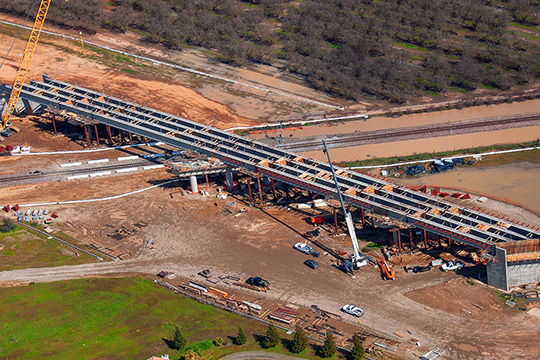Central Valley
The California High-Speed Rail Authority (Authority) is continuing construction while partnering with local agencies, community members, business owners and other key stakeholders to build the nation’s first high-speed rail system.
What’s Happening
Jobs
Historically, the Central Valley’s economy has lagged behind the rest of the state. Now, investment in high-speed rail is helping to close the gap.
- More than 16,000 jobs have been created with the help of the State Building and Construction Trades Council, the Fresno Regional Workforce Development Board and other groups.
- 30% of all project work hours are to be performed by National Targeted Workers (someone who lives within an economically distressed area, such as the Central Valley).
- In the city of Selma, the Central Valley Training Center opened to help students prepare for careers in more than 10 different construction-industry trades and has graduated multiple cohorts already.
Clean Air
The Central Valley Basin doesn’t meet current clean-air objectives.
- The Authority partnered with the San Joaquin Valley Unified Air Pollution Control District as one of the means to achieve the project’s goal of net-zero greenhouse gas and criteria pollutant emissions.
- Contractors must use Tier 4 construction equipment or equipment retrofitted to achieve comparable standards throughout the project.
- An interagency agreement with the California Department of Forestry and Fire Protection is in place to plant trees through the Forestry Assistance and Urban and Community Forestry programs.
Reconnecting the State
Home to nearly seven million people, the Central Valley is one of the fastest growing regions in the state.
- As the backbone of the State Rail Plan, high-speed rail will connect the region to the rest of California.
- More than $9.6 million in economic output in the Central Valley from July 2006 to June 2024.
Construction Packages & Stations
Explore below for details on high-speed rail stations and construction packages in the Central Valley. In September 2020, the Authority’s Board of Directors approved the final environmental documents for the section referred to as the “Central Valley Wye”, providing full environmental clearance for the 171 miles of high-speed rail alignment between Merced and Bakersfield.
The Authority continues to work with local partners to develop station area plans based around proposed high-speed rail centers. The Authority executed three design-build construction contracts for the Central Valley Segment of the high-speed rail system.
Want More Information?
Find more information about high-speed rail in California. From factsheets and regional newsletters, to maps and outreach events, get on board with the most up‑to‑date program information.
Regional NewsletterVisit buildHSR





